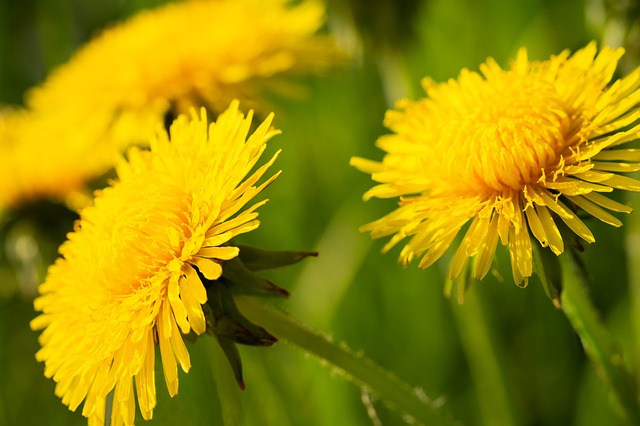 |  |  |   |  |
 |  |  |  |
Common Dandelion
is a perennial plant that grows to a height of 50 cm. Dandelion has short roots, but in the middle there is one strong and fleshy root 20-60 cm long. 1-2 cm in diameter, reddish brown on top, white inside. The leaves are elongated with a robotic edge, on average 20 cm long, which grow from a root rosette.
The flower stem is erect, without leaves, up to 40 cm tall, at the end of which there is a golden yellow inflorescence with an average diameter of 3-5 cm. The calyx of the inflorescence contains up to 200 tongue-shaped flowers of both sexes.
The biggest flowering time of the
Common Dandelion
began in May, often repeated flowering and seed formation can be observed during the summer. The seeds are formed with a fluffy "parachute", on average 3-4 cm long. Ripe seeds are sown long distances by the wind. The plant is rich in milk.
Dandelion roots (Radices Taraxaci), which are harvested from August to October, are used in medicine. Also collect the root together with the rosette of leaves, in early spring before flowering.
Dandelion roots are cleaned from the remains of leaves, side roots, root tip and upper neck, washed in cold running water. The prepared roots are twisted for a couple of days and finish drying in ovens at a temperature of 40-50C.
Dandelion root contains the polysaccharide inulin (25-40%), the amount of which increases as autumn approaches and decreases as spring approaches (up to 2%), the bitter glycoside taraxacin, triterpene compounds (taraxol, taraxasterol, taraxerol, homotaraxasterol, pseudotaraxasterol, beta-amyrin) and sterols. (beta-sitosterol and stigmasterin), proteins (up to 15%), apigenin, asparagine, rubber (2-3%), sugar, organic acids, essential oils, resins, mucilage, tyrosinase; vitamins A, B1, B2, C, niacin, nicotinamide, choline, various caratonoids (taraxanthin, flavoxanthin, lutein, violaxanthin), flavonoids, wax; minerals potassium and calcium, vegetable fats consisting of linoleic glycerides, palmitic acid, oleic acid, malic acid and cerotic acid, tannins, alkali (8%).
Common Dandelion
roots contain the bitter substance lactucopicrin, which breaks down into n-oxyphenylacetic acid and the sesquiterpene lactone lactucin. It also contains amyrin, taraxerol and acids - caffeic acid, P-coumaric acid and cerotinic acid; triterpene alcohols: arnidiol and faradiol.
Dandelion milk contains bitter glycosides (taraxacin). Carotonoids have been found in inflorescences and leaves: taraxanthin, faradiol, flavoxanthin, lutein. The leaves contain vitamins B2 and C, iron, phosphorus and calcium.
Medicinal significance
Common Dandelion
belongs to plants that contain bitter substances. It is used to improve digestion and appetite. Dandelion acts as reflectors, irritating the taste receptors on the tongue and the mucous membrane of the oral cavity, which promotes the activation of the esophagus and further the secretion of gastric juice increases, correspondingly the other glands involved in the digestive process are also activated. According to phytotherapists of different countries, dandelion is the best stimulator of liver function.
Modern medicine recognizes that
Common Dandelion
has a choleretic and antiatherosclerotic effect, inhibiting the absorption of cholesterol, helps remove toxins from the blood, strengthens the pancreas, increasing the release of insulin.
Milkweed juice is an effective diuretic. And it is a powerful source of potassium, which is usually flushed out of the body with urine. Dandelion leaf juice keeps the digestive organs in tone and boosts metabolism. This juice can also be considered rejuvenating.
In folk medicine, preparations from dandelion root are used to improve appetite and digestion, to treat chronic gastrointestinal diseases (gastritis, ulcers, atonic constipation), liver diseases, spleen diseases, cholecystitis, jaundice, kidney stones and gallstones, gout, hemorrhoids, skin allergies and for the treatment of diseases, insomnia, neurosis, avitaminosis, atherosclerosis, anemia, pulmonary tuberculosis, edema.
Common Dandelion
root decoction is used in folk medicine as an anti-inflammatory, temperature-reducing, sweat-repelling, milk-repelling, sugar-lowering, wound-healing, bile-repelling, anti-parasitic agent, and it can also be used in various inflammations, inflammation of the lymph nodes, inflammation of the stomach (gastritis ), inflammation of the gall bladder (in the case of gallstones), inflammation of the spleen and other cases.
Juice is squeezed from the leaves to reduce swelling and remove excess fluid from the body, especially if it is associated with heart disease or urinary disorders.
In European countries, decoctions of dandelion leaves are used in dermatology to treat eczema, atopic dermatitis, urticaria, etc.
In the northern part of Europe, it is more often used in diabetes mellitus and pulmonary tuberculosis.
In Asian medicine,
Common Dandelion
is used to treat lymph node inflammation, hypogalactia, and snakebite. Also, all parts of the dandelion are used as a tonic, diaphoretic, antipyretic and appetite stimulant.
For men
Dandelion roots are used to treat impotence caused by alcoholism or ST diseases. The leaves are used to improve the tone of the body. In mixtures, dandelion roots are used to treat prostate adenoma, as well as acute and chronic prostatitis. Interestingly, the roots of the plant will affect both sexes and increase sexual interest.
